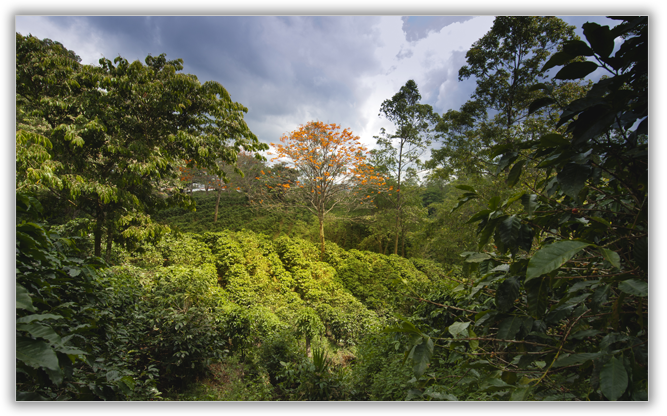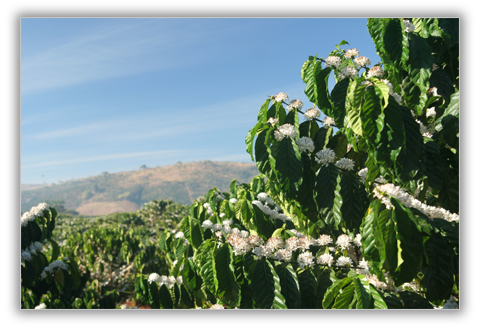 |
HALĒ KAI LANA KONA COFFEE - 175 Years in the Making
Easterly trade winds move across the great expanses of the Pacific Ocean before reaching the Hilo side of the Big Island where they are tempered after rising up the eastern slope of Mauna Loa which rises to 13,000 feet. The breezes that make it over the top of the volcano to Kona on the leeward western slope are gentle enough to leave the delicate Kona coffee flowers there unharmed.
The first coffee plants were brought to Kona in the early 1800s by American Protestant missionary Reverend Samuel Ruggles. These coffee plants were from Brazilian cuttings.
There are more than 700 estate and commercial coffee farms in North and South Kona.
About 20,000 to 40,000 pounds of cherry may be produced on a three to five acre Kona coffee farm. In other places an acre of coffee trees has produced more than 10,000 pounds of cherry, which reduce to about 2,000 pounds after milling.
Most Kona Coffee Farms are about two to seven acres in size. The average size of a Kona Coffee farm is less than five acres, and most of these Kona coffee farms are family-run operations. In all, about 4,000 acres in Kona are farmed in coffee. As an example, one of the larger farms is 30 acres and grows nearly 20,000 coffee trees.

The multi-ethnic heritage of Kona coffee farming over the last century has included many Japanese, Hawaiians, Caucasians, Chinese, Portuguese, Koreans, Filipinos, Samoans, Puerto Ricans, and others. In the early years of coffee farming in Kona, the Japanese quickly became the most prominent group, and at one point, four out of five Kona coffee farmers were Japanese. Today many Kona coffee farmers can claim to be fifth generation descendants of the original Kona coffee farmers.
Production varies with climate and other factors, but about two million pounds of (green) coffee were produced in Kona in 1997 on about 2,300 acres of land. Today about 3 million pounds of green coffee beans are produced in Kona each year, from about 15 million pounds of cherry (about 19% by weight) and then this weight will be reduced by another 20% from roasting.
Coffee trees begin to bear fruit after three years. Coffee plants are classified botanically as bushes or shrubs, although in the coffee-growing industry they are commonly referred to as trees.
Native to subtropical Africa and southern Asia, the Coffea plant is an evergreen shrub/small tree in a genus of ten species of flowering plants of the family Rubiaceae. The coffee tree has dark, green, glossy leaves and clusters of fragrant, white flowers that bloom simultaneously. The fruit berry is oval, about 1.5 centimeters (0.6 in) long, and green when immature, ripening to yellow, crimson, and finally dark red/black when it dries – it takes about 8 months for the berries to ripen. Berries usually contain two seeds, but in about 7.5% of the berries, there is only one seed – these are known as peaberries.

The two main cultivated coffee species worldwide are Coffea canephora (Robusta) and Coffea arabica (Arabica). Arabica coffee is considered more suitable for drinking than Robusta, which tends to be more bitter and with less flavor. About three-fourths of coffee cultivated worldwide is Arabica. Robusta, however, is less susceptible to disease and can be cultivated in some environments where Arabica does not grow well. Robusta coffee also contains about 45% more caffeine than Arabica.
Coffee can grow to more than thirty feet tall, but the trees on Hawaiian Kona coffee farms are pruned on a regular basis to encourage cherry production and to make harvesting easier.
A variety of tasks are required to maintain the orchards including fertilization and also suckering, which involves removing young branch starts from the limbs and trunks of the coffee trees.
 From the National Coffee Association of USA
From the National Coffee Association of USA
“Though coffee farms are found throughout the Hawaiian islands, it is Kona coffee, from the large island of Hawaii, that is best known and always in high demand. Nature provides just the right environment for the coffee trees growing on the slopes of the active Mauna Loa volcano. Young trees are planted in black, volcanic soil so new that it often seems the farmers are planting their seedlings in rock instead of soil. Afternoon shade from tropical clouds forms a natural canopy over the trees to protect them from intense sun. Frequent island showers keep the plants nourished with just the right amount of rain. Kona coffee is carefully processed and produces a deliciously rich, aromatic cup of medium body.”
|
|
|